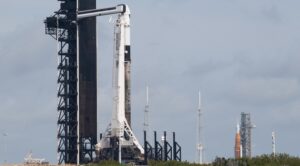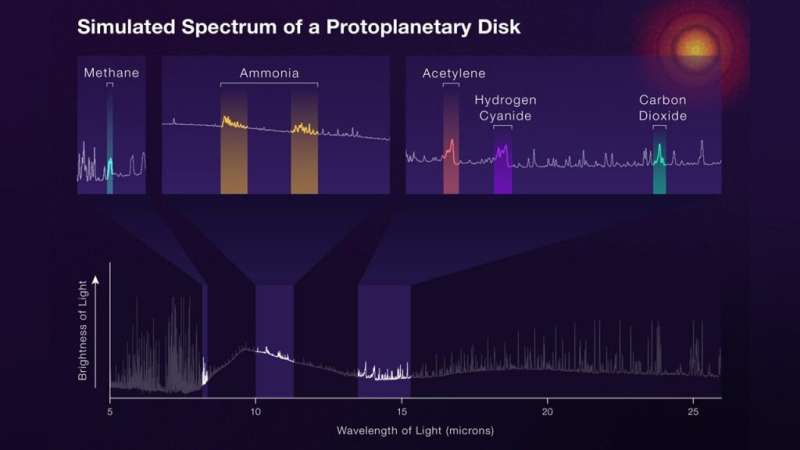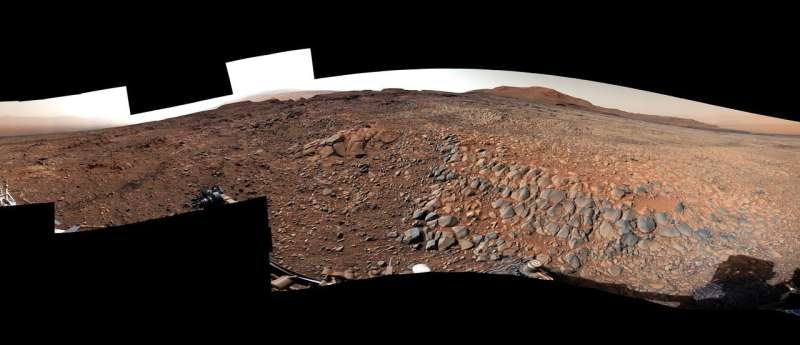Arianespace wins new contract to launch Sentinel-1C observation satellite on board Vega-C
Friday, 08 April 2022 06:25 Arianespace has been awarded a launch contract by the European Space Agency (ESA) on behalf of the European Commission, to launch Sentinel-1C in the first half of 2023 on Vega-C. The satellite, weighing around 2.3 metric tons, will be placed in a Sun-synchronous orbit with an altitude around 690 km.
"We are very proud of this new launch contract for the European Commission and the European
Arianespace has been awarded a launch contract by the European Space Agency (ESA) on behalf of the European Commission, to launch Sentinel-1C in the first half of 2023 on Vega-C. The satellite, weighing around 2.3 metric tons, will be placed in a Sun-synchronous orbit with an altitude around 690 km.
"We are very proud of this new launch contract for the European Commission and the European UCF part of historic civilian space flight to ISS
Friday, 08 April 2022 06:25 When the first four civilians travel to the International Space Station April 8 they will be working with a team of University of Central Florida doctors to study how space travel affects the human body, particularly the eyes and brain.
Three faculty physicians at UCF Health, the College of Medicine's clinical practice, are collaborating with Axiom Space and two Israeli medical centers - S
When the first four civilians travel to the International Space Station April 8 they will be working with a team of University of Central Florida doctors to study how space travel affects the human body, particularly the eyes and brain.
Three faculty physicians at UCF Health, the College of Medicine's clinical practice, are collaborating with Axiom Space and two Israeli medical centers - S Got a hitch in our giddyup - Sols 3437-3438
Friday, 08 April 2022 06:25 We successfully drove further down off of the "Greenheugh pediment" as we head toward smoother driving pathways downhill. However, the chaotic jumble of terrain we encountered in the final few rolls of our wheels left a couple of our wheels perched awkwardly.
That meant we could not get out the arm for contact science, lest our large arm swinging around cause the rover to shift unexpectedl
We successfully drove further down off of the "Greenheugh pediment" as we head toward smoother driving pathways downhill. However, the chaotic jumble of terrain we encountered in the final few rolls of our wheels left a couple of our wheels perched awkwardly.
That meant we could not get out the arm for contact science, lest our large arm swinging around cause the rover to shift unexpectedl SmallSat launch company teams with C8 Secure for cybersecurity
Friday, 08 April 2022 06:25 SmallSat launch services provider Vaya Space announced their strategic partnership with C8 Secure to provide turn-key cybersecurity solutions for the space industry. In addition, Vaya Space has agreed to provide launch services to Continent 8 Technologies, the parent corporation of C8 Secure, as they develop and implement plans to create a new satellite constellation to augment their global netw
SmallSat launch services provider Vaya Space announced their strategic partnership with C8 Secure to provide turn-key cybersecurity solutions for the space industry. In addition, Vaya Space has agreed to provide launch services to Continent 8 Technologies, the parent corporation of C8 Secure, as they develop and implement plans to create a new satellite constellation to augment their global netw US Space Force taps Space Micro to build GEO Lasercom Terminals
Friday, 08 April 2022 06:25 Space Micro Inc., powered by Voyager Space, and a provider of digital, electro-optic and communications systems for satellites, deep space exploration and other space equipment, today announced an award from the U.S. Space Force, Space Systems Command for a contract to build a GEO-capable uLCT secure laser communications terminal. Under the contract, Space Micro plans to deliver a flight model t
Space Micro Inc., powered by Voyager Space, and a provider of digital, electro-optic and communications systems for satellites, deep space exploration and other space equipment, today announced an award from the U.S. Space Force, Space Systems Command for a contract to build a GEO-capable uLCT secure laser communications terminal. Under the contract, Space Micro plans to deliver a flight model t Space Force announces candidate locations for STARCOM HQ, Deltas
Friday, 08 April 2022 06:25 The Department of the Air Force selected six candidate locations for U.S. Space Force's Space Training and Readiness Command Headquarters, April 4.
All USSF bases are candidate locations under consideration, which include Los Angeles Air Force Base, California (will be renamed a Space Force Base in the future), Vandenberg SFB, California, Buckley SFB, Colorado, Schriever SFB, Colorado, Pet
The Department of the Air Force selected six candidate locations for U.S. Space Force's Space Training and Readiness Command Headquarters, April 4.
All USSF bases are candidate locations under consideration, which include Los Angeles Air Force Base, California (will be renamed a Space Force Base in the future), Vandenberg SFB, California, Buckley SFB, Colorado, Schriever SFB, Colorado, Pet Second Successful Flight for DARPA Hypersonic Air-breathing Weapon Concept (HAWC)
Friday, 08 April 2022 06:25 DARPA and its U.S. Air Force partner recently completed a free flight test of the Lockheed Martin version of the Hypersonic Air-breathing Weapon Concept (HAWC). The vehicle, after release from a carrier aircraft, was boosted to its Aerojet Rocketdyne scramjet engine ignition envelope. From there, it quickly accelerated to and maintained cruise faster than Mach 5 (five times the speed of sound) f
DARPA and its U.S. Air Force partner recently completed a free flight test of the Lockheed Martin version of the Hypersonic Air-breathing Weapon Concept (HAWC). The vehicle, after release from a carrier aircraft, was boosted to its Aerojet Rocketdyne scramjet engine ignition envelope. From there, it quickly accelerated to and maintained cruise faster than Mach 5 (five times the speed of sound) f NASA finds new way to monitor underground water loss
Friday, 08 April 2022 06:25 Scientists have produced a new method that holds the promise of improving groundwater management - critical to both life and agriculture in dry regions. The method sorts out how much underground water loss comes from aquifers confined in clay, which can be drained so dry that they will not recover, and how much comes from soil that's not confined in an aquifer, which can be replenished by a few
Scientists have produced a new method that holds the promise of improving groundwater management - critical to both life and agriculture in dry regions. The method sorts out how much underground water loss comes from aquifers confined in clay, which can be drained so dry that they will not recover, and how much comes from soil that's not confined in an aquifer, which can be replenished by a few NASA releases breakthrough forest biomass-carbon product
Friday, 08 April 2022 06:25 NASA's GEDI mission has reached a major milestone with the release of its newest data product, which provides the first near-global estimate of aboveground forest biomass and the carbon it stores - filling a key gap in climate research.
The data enables research into how Earth's forests are changing, what role they play in mitigating climate change, and the regional and global impacts of p
NASA's GEDI mission has reached a major milestone with the release of its newest data product, which provides the first near-global estimate of aboveground forest biomass and the carbon it stores - filling a key gap in climate research.
The data enables research into how Earth's forests are changing, what role they play in mitigating climate change, and the regional and global impacts of p Ride into orbit secured for Copernicus Sentinel-1C
Friday, 08 April 2022 06:00
A contract signed with Arianespace secures the launch for the third Copernicus Sentinel-1 satellite. Scheduled to lift off on ESA’s new Vega-C rocket from Europe’s Spaceport in French Guiana in the first half of 2023, Sentinel-1C will continue the critical task of delivering key radar imagery for a wide range of services, applications and science – all of which benefit society.
Ride into orbit secured for Sentinel-1C
Friday, 08 April 2022 06:00
A contract signed with Arianespace secures the launch for the third Copernicus Sentinel-1 satellite. Scheduled to lift off on ESA’s new Vega-C rocket from Europe’s Spaceport in French Guiana in the first half of 2023, Sentinel-1C will continue the critical task of delivering key radar imagery for a wide range of services, applications and science – all of which benefit society.
BlackSky looks to expand its military business amid growing interest in commercial satellite imagery
Thursday, 07 April 2022 22:19
Amid a surge in demand for satellite imagery, BlackSky is looking to expand its national security and defense business.
The post BlackSky looks to expand its military business amid growing interest in commercial satellite imagery appeared first on SpaceNews.
Private astronaut mission cleared for launch
Thursday, 07 April 2022 21:15
The first commercial mission by an American spacecraft to the International Space Station is ready for launch as a pathfinder for a new era of commercial orbital human spaceflight.
The post Private astronaut mission cleared for launch appeared first on SpaceNews.
Webb telescope's cool view on how stars, planets form
Thursday, 07 April 2022 20:48
The ongoing success of the multi-instrument optics alignment for NASA's Webb telescope's near-infrared instruments has moved the attention of the commissioning team to chill as we carefully monitor the cooling of the Mid-InfraRed Instrument (MIRI) down to its final operating temperature of less than 7 kelvins (-447 degrees Fahrenheit, or -266 degrees Celsius). We are continuing other activities during this slow cooldown which include monitoring the near-infrared instruments. As MIRI cools, other major components of the observatory, such as the backplane and mirrors, also continue to cool and are approaching their operational temperatures.
Curiosity Mars Rover reroutes away from 'gator-back' rocks
Thursday, 07 April 2022 20:41
NASA's Curiosity Mars rover spent most of March climbing the "Greenheugh Pediment"—a gentle slope capped by rubbly sandstone. The rover briefly summited this feature's north face two years ago; now on the pediment's southern side, Curiosity has navigated back onto the pediment to explore it more fully.

